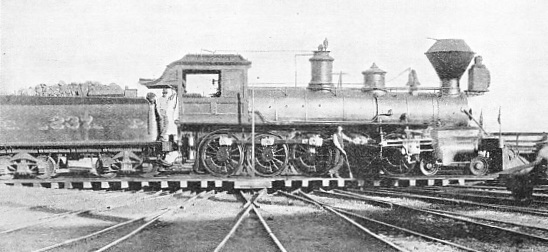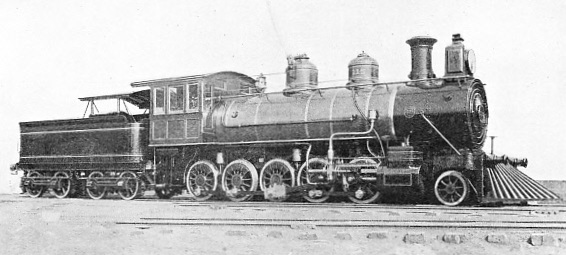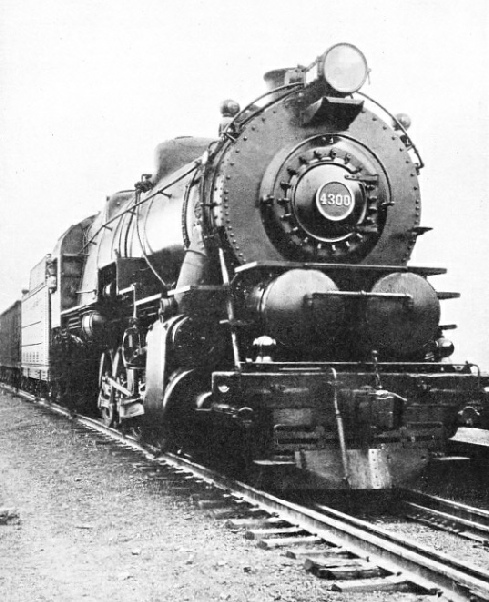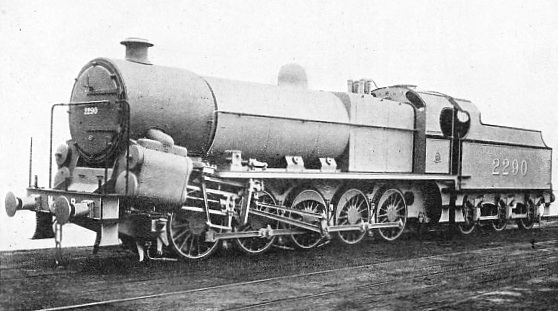The Evolution of the Ten-Wheels-Coupled, the Heaviest and Most Powerful Single Engine for the Movement of Merchandise
LOCOMOTIVES - 42

“EL GUBERNADOR”, THE FIRST LOCOMOTIVE TO BE FITTED WITH TEN COUPLED DRIVING WHEELS
Built for the Central, now the Southern Pacific Railroad, in 1884, this gigantic fourteen-wheeler was designed to haul the heavy freight trains over the Tehachapi Mountains of California. Owing to the boiler being too small for the huge cylinders, the locomotive was scrapped in 1894.
WHEN William Hood, the chief engineer to the Southern Pacific Railway, finally discovered how to overcome the 4,000 feet of ascent in 46 miles to carry the railway from Bakersfield over the Tehachapi mountain range in Southern California by his wonderful loop, the question of moving the trains economically up the long bank rising steadily at 115 feet per mile, presented the locomotive engineers with some exacting problems. In the first instance ten-wheelers - 4-6-0 - with cylinders 18 by 24 inches, working at 165 lb per square inch pressure of steam; 57-inch driving wheels weighing 25,600 lb per pair; with 92,000 lb of the total weight of 109,900 lb available for adhesion; and a draw-bar pull of 19,130 lb were put to work upon this big hill. They were the largest freight engines of their day upon the system, and, it is interesting to remark, three still survive in service.
At the time these engines were delegated to the “Tehachapi Toil” the line over the mountains was laid with rails weighing 50 lb per yard, but in 1882 it was relaid with 62-lb rails. This achievement was considered to be so notable as to induce Governor Leland Stanford, the president of the Southern Pacific, to express the desire for a locomotive representing as great an advance in dimensions, weight and power over the existing ten-wheeler as was the 62- over the 50-lb rail.
The chief mechanical engineer at that time was A. J. Stevens, and he assured Governor Stanford of the practicability of the idea. Thereupon, in the way they had of doing things in those times, the presiding genius of the executive gave the engineer carte blanche, then and there, to build the engine, and, apparently, no particular record was made of the order. Such a system may seem haphazard, but those were pioneer days, although in this instance it brought a train of troubles in its wake, as Mr. H. Stillman, then a draughtsman in the Sacramento shops of the Southern Pacific, but now the mechanical engineer, and supervisor of tests, has communicated to me. Stevens entered into the spirit of the enterprise with zest, and the task of preparing the designs for what was to be the largest and heaviest locomotive in the world was assigned to Mr. Stillman.
Some eight or ten months after the momentous conversation between the president and his mechanical engineer, Governor Stanford went to Europe with his family for a holiday. During his absence his colleague, Vice-President Charles Crocker, visited the Sacramento locomotive shops on a tour of inspection. Wandering through the works Crocker’s attention was arrested by the immense frame-forgings for the new locomotive. He paused for a moment, and puckering his brows in perplexity, asked querulously:
“What are these? ”
“The frames for the big locomotive we are building!”
“Big locomotive!” repeated Crocker.
“What big locomotive? It’s all news to me. I want this work stopped immediately!”
So the enterprise was suspended. When Stanford returned he bethought himself of the monster engine, only to learn that all work upon it had been stopped. Ascertaining the reason he hurriedly conferred with his associates, and succeeded in persuading them to support the venture; the order for resumption of construction was given to be pushed ahead with such swing as to enable the engine to be completed early in 1884.
The monster, appropriately named “El Gubernador”, after Governor Stanford, and with the road number “237”, made its trial trip on March 1 of the year mentioned from the Sacramento shops to American River Bridge. Its appearance arrested the attention of the employees, while the deep tone of its bell caused people living beside the line to run out of their homes as though impressed with the idea, to quote a contemporary scribe, “that a church had broken loose or that a steamboat was coming around looking for water”.
The only specification governing the building of “El Gubernador” was that “it should be as much heavier as the existing heaviest engine as the new 62-lb rail was heavier than the 50-lb rail.” It was a fourteen-wheeler with ten coupled wheels - 4-10-0 - and so was really a “decapod” - the first of its race. The cylinders had a diameter of 21 inches by 36 inches stroke, and used steam at a pressure of 140 lb. The driving wheels were 57 inches in diameter, and carried a weight of 146,000 lb, while the tractive effort was 33,145 lb. How effectively the desire of the railway president to obtain a locomotive as far in advance of the existing in point of weight as was the 62-lb in regard to the 50-lb rail was satisfied, may be gathered from the fact that whereas the increase in the weight of the rail represented 31 per cent, “El Gubernador” had an increase in adhesive weight of 32 per cent, over the ten-wheeler then in use upon the mountain, while its draw-bar pull was 73 per cent, greater.
There were other features of this locomotive which were quite as novel as her ten coupled wheels. The valve-gear was of the Stevens double-valve type, really a modification of the Walschaert valve-gear so extensively favoured to-day. The fire-box was far more generous in dimensions than that usually recognized at the time. To enable the five drivers to negotiate the sharpest curves readily, the fifth pair of wheels were provided with ball-shaped crank-pins, to give side radial play to the back connecting rod. All these features are to be found in the modern locomotive, but they were distinct innovations in 1884.
Shortly after completion the “Governor” - promptly abbreviated to “The Guv’nor” by those associated with her operation - was sent down to the Tehachapi Mountains for freight service between Mojave and Caliente, but to enable her to pass over the comparatively light bridges and rails en route the locomotive had practically to be dismantled. Upon re-erection the giant of the rails went into commission. Careful rules and regulations were laid down in connexion with her operation, her immensity apparently exercising a somewhat intimidating influence. She was run only during the hours of daylight, and was returned to Mojave in reverse, on account of her size, and from the thought that it would be unsafe to turn her on the mountain. Her normal load was 24 cars, the capacity of the heaviest of which was 40,000 lb, and in moving this train she did the work of two ten-wheelers. A specially selected driver had charge of her, and she had command of the road at all times, instructions being issued to the effect that all trains, passenger expresses and “Limiteds” included, were to make for the nearest siding when meeting “El Gubernador” and her train; the latter was not to be delayed or held up under any consideration.
Unfortunately for her fathers, “El Gubernador” did not prove the anticipated success. The boiler was found to be too small to make sufficient steam to supply the large cylinders. During the preparation of the designs the question of the boiler dimensions was raised, but Mr. Stevens concluded that his conception would prove adequate for the duty. In hauling capacity the locomotive completely fulfilled the expectations of those associated with her creation, but, in the language of the boys on the road, “she chewed up all the coal in the country”. At times two firemen had to be carried to maintain the steam and many changes were made in the draught appliances to this end, but to no avail. As one of the old drivers pointedly remarked: “All hell couldn’t make her steam!”
These deficiencies notwithstanding, “The Guv’nor” was kept on the mountain pull until late in the ‘eighties, although the reports of her working, which were far from satisfactory, constituted a topic of acrimonious discussion and heated argument between the “Big Four” who were behind the railway. When withdrawn from the run she was taken back to the Sacramento shops and run into a side-track to await the construction of a bigger boiler. This, however, never materialized. The wrangle over “Stanford’s Dream” among the executive became so acute that boiler reconstruction, whenever mooted at the meetings of the executive, was so repeatedly shelved as to lead to the summary decision in 1894 to end all further dispute, by sending her to the scrap-heap. “El Gubernador”, as in the case of the Great Eastern of marine transportation history, was premature, but the sudden decision to break her up came unexpectedly, while the true reason for such action has never been known, and probably will remain an unsolved mystery for all time.

THE FIRST “DECAPOD” (2-10-0) BUILT BY THE BALDWIN LOCOMOTIVE WORKS FOR THE DOM PEDRO SECUNDO, NOW THE CENTRAL RAILWAY OF BRAZIL. It is so-named because it has ten wheels (feet). The driving wheels were 45 inches in diameter, and carried 126,000 lb of the total weight (141,000 lb) of the engine in working order.
In 1885 the Dom Pedro Segundo Railway of Brazil - the title was changed to the Central Railway of Brazil upon the declaration of the Republic in 1889 - which, although the trunk road of the country, has severe gradients, called for a powerful locomotive for the movement of a train weighing 500 tons over banks of 1 in 50. Baldwin responded with an engine with ten coupled wheels and a leading pony truck. This was the heaviest engine built up to this time in the Philadelphia works. From its possession of ten driving wheels (feet) it was called the “Decapod”. The cylinders were 22 by 26 inches; while the driving wheels were 45 inches in diameter and grouped in a driving wheel-base of 17 feet. In full working order the engine weighed 141,000 lb, with 126,000 imposed on the drivers.
In addition to its hauling capacity the locomotive had to be capable of rounding curves as sharp as 500-feet radius, and this was provided for in the following manner. The front pair of wheels were flanged, as usual, but the second and third pairs were without these flanges. The fourth and fifth pairs were flanged, but the rear wheels were given ¼-inch more lateral play on the rails than the pair immediately preceding. The flanges of the first and fourth pairs of driving wheels made virtually a rigid wheelbase of 12 feet 8 inches and so determined the friction on a curve.
The “Decapod” classification is most powerfully represented now in the current engines of this family, designed and built in the Juniata shops of the Pennsylvania Railroad system; the first of these was ready for service in December, 1916. This striking unit, which is built to operate on curves of 350-feet minimum radius, is the heaviest and most powerful single locomotive upon the system. It measures 73 feet 0½-inch overall; the total wheel-base of the engine is 32 feet 8 inches, and the driving wheel-base 22 feet 8 inches.
The Belpaire fire-box, of the standard Pennsylvania design, has a minimum internal diameter of 82 inches, carrying 714 tubes, 228 inches in length, between sheets, and ranging from 1 3/16 to 2¼ inches in diameter. The total heating surface of the boiler is 7,277 feet, and it is built for a working pressure of 250 lb per square inch. The grate area is 60·98 square feet, the fire-box measuring 79⅞ inches by 126 inches inside. The cylinders, having a spread of 7 feet 7½ inches, are 30½ inches in diameter by 32 inches stroke. The valve-gear, of the Walschaert type, has its cut-off limited to 50 per cent.

THE GIANT FREIGHT “DECAPOD” OF THE PENNSYLVANIA RAILROAD
This locomotive represents the most powerful expression of this classification. Its overall measurement is 73 0½ inch. The ten driving wheels are 62 inches in diameter, and the wheels of the leading pony truck and the tender are 33 inches in diameter. Above the buffer beam, tow of the main compressed air reservoirs are seen. There are 122 of these locomotives in service.
The ten driving wheels are 62 inches in diameter, the leading and rear pairs, 5½ inches wide, being flanged. The tires of the three pairs between are bald or flangeless; those on the central axle are 8½ inches in width, while the second and fourth pairs are 7½ inches wide. The wheels of the leading pony truck, as well as those of the eight wheels carrying the tender, are 33 inches in diameter; the footplate is 6 feet 11 inches above the level of the rail; the tender has capacity for 9,000 gallons of water and 35,000 lb of coal.
There are two cylinders for braking the driving wheels. They are 18 inches in diameter by 13-inches stroke, and exert a braking effort of 230,000 lb. Both these cylinders are placed on the vertical centre line of the engine, one with its axis in the horizontal, and the other in the vertical, plane, respectively. The reverse gear is operated by power instead of by hand; to provide space for this, as well as the feed-water-heater, two of the main compressed air reservoirs have been placed on the bumper or buffer beam. To facilitate passing from one side running-board to the other these main reservoirs are spanned by a narrow deck.
The performance of the first “Decapod” fully substantiated the expectations of the Pennsylvania Railroad technicians. It proved conclusively that the saving in steam and coal, by the use of the restricted cut-off of 50 per cent, of stroke maximum, averaged about 20 per cent. Trials made in the locomotive testing station maintained by the railway showed an average coal consumption of 275 lb of coal per dynamometer horse-power for loads and speeds encountered in service. As these tests were so eminently satisfactory the Juniata shops were instructed to proceed with the construction of 122 of these “Decapods”. Service by the fleet, during the four years or more it has been in service, having confirmed the results attained with the first locomotive, the design has been established as the standard for heavy freight duty upon the Pennsylvania system.

A STRIKING EXPRESSION OF THE “DECAPOD” IN EUROPEAN SERVICE. Freight locomotive of the North Railway of France. The driving wheels are 61.02 inches in diameter; those of the pony truck, 40.94 inches. Overall length of the locomotive, buffer to buffer, 62 feet 3.5 inches, and total weight, ready for the road, 137.595 tons.
A striking European expression of the “Decapod” is offered by the four locomotives of this type built by the Chemin de Fer du Nord for the movement of the mineral traffic from the Lens coal-field. The trains are not only long and heavy but the banks, for western Europe, are unusually severe. The locomotives are of the compound type, though originally one was built as a simple engine, but has since been converted to the first-named system.
The high-pressure cylinders, placed outside and driving the third pair of coupled wheels, are 19·29 inches in diameter by 25·19-inches stroke. The low-pressure cylinders, set inside, and somewhat inclined, to drive the second coupled axle, are 26·77 inches in diameter and have a stroke of 27·56 inches. The boiler, with a mean internal diameter of 64·52 inches, carries 90 tubes, 236·2 inches in length, between plates, with a heating surface of 2,521·46 square feet. The fire-box is 187·08 square feet, giving a total heating surface of 2,708·54 square feet. The grate area is 34·66 square feet. The superheater is composed of 24 elements, giving a total heating surface of 669·84 square feet. The working pressure of the boiler is 227 lb per square inch, and its horse-power 1,800.
The driving wheels are 61·02 inches in diameter; that of the pony truck wheels 40·94 inches. The rigid wheel-base is 17 feet 5·44 inches; total wheel-base 33 feet 2·44 inches; overall length of engine 43 feet 9·78 inches, while its extreme height above the rail is 13 feet 10·53 inches. The six-wheel tender has capacity for 2,245 gallons of water and 4 tons of fuel; its weight, empty, registers 17·175 tons. The overall length of the locomotive, buffer to buffer, is 62 feet 3·5 inches, and its total weight, ready for the road, 137·595 tons. Of this amount the engine represents 99·07 tons, with 88·37 tons available for adhesion. The Westinghouse direct and automatic brake acting upon every wheel is fitted. The theoretical tractive effort registers 52,066 lb when working compound, and, with direct admission of the steam to the low-pressure cylinders, it amounts to 71,649 lb.

A BRITISH EXPRESSION OF THE “DECAPOD” ON THE LONDON, MIDLAND, AND SCOTTISH RAILWAY
This locomotive is used for banking on the Lickey Incline, near Birmingham. Total weight (engine and tender), 235,732 lb; total length, 61 feet O⅝ inch; wheels, 55½ inches in diameter; cylinders, 16¾ inches by 28-inches stroke.
You can read more on “Giant American Locomotives”, “Locomotive Giants - 2” and “The Mountain Type” on this website.







